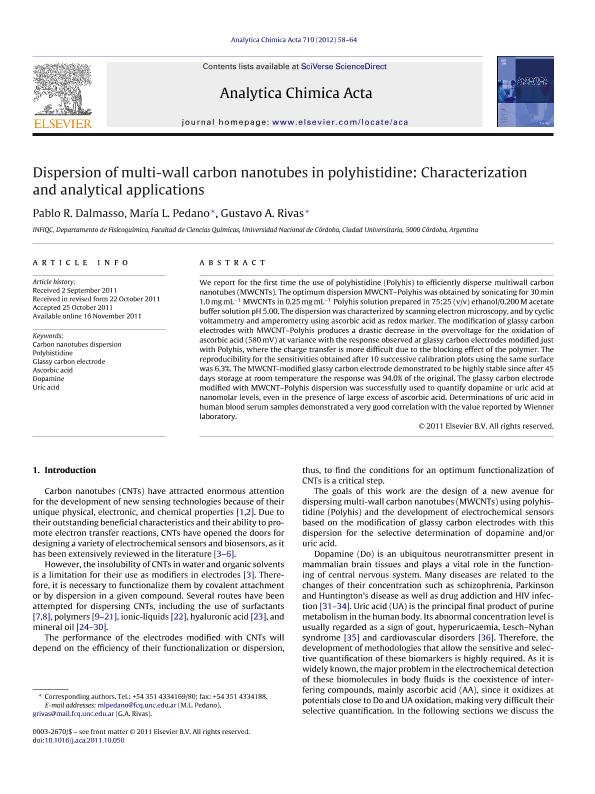Artículo
Dispersion of multi-wall carbon nanotubes in polyhistidine: Characterization and analytical applications
Fecha de publicación:
01/2012
Editorial:
Elsevier Science
Revista:
Analytica Chimica Acta
ISSN:
0003-2670
Idioma:
Inglés
Tipo de recurso:
Artículo publicado
Clasificación temática:
Resumen
We report for the first time the use of polyhistidine (Polyhis) to efficiently disperse multiwall carbon nanotubes (MWCNTs). The optimum dispersion MWCNT-Polyhis was obtained by sonicating for 30min 1.0mgmL -1 MWCNTs in 0.25mgmL -1 Polyhis solution prepared in 75:25 (v/v) ethanol/0.200M acetate buffer solution pH 5.00. The dispersion was characterized by scanning electron microscopy, and by cyclic voltammetry and amperometry using ascorbic acid as redox marker. The modification of glassy carbon electrodes with MWCNT-Polyhis produces a drastic decrease in the overvoltage for the oxidation of ascorbic acid (580mV) at variance with the response observed at glassy carbon electrodes modified just with Polyhis, where the charge transfer is more difficult due to the blocking effect of the polymer. The reproducibility for the sensitivities obtained after 10 successive calibration plots using the same surface was 6.3%. The MWCNT-modified glassy carbon electrode demonstrated to be highly stable since after 45 days storage at room temperature the response was 94.0% of the original. The glassy carbon electrode modified with MWCNT-Polyhis dispersion was successfully used to quantify dopamine or uric acid at nanomolar levels, even in the presence of large excess of ascorbic acid. Determinations of uric acid in human blood serum samples demonstrated a very good correlation with the value reported by Wienner laboratory. © 2011 Elsevier B.V.
Archivos asociados
Licencia
Identificadores
Colecciones
Articulos(INFIQC)
Articulos de INST.DE INVESTIGACIONES EN FISICO- QUIMICA DE CORDOBA
Articulos de INST.DE INVESTIGACIONES EN FISICO- QUIMICA DE CORDOBA
Citación
Dalmasso, Pablo Roberto; Pedano, Maria Laura; Rivas, Gustavo Adolfo; Dispersion of multi-wall carbon nanotubes in polyhistidine: Characterization and analytical applications; Elsevier Science; Analytica Chimica Acta; 710; 1-2012; 58-64
Compartir
Altmétricas




